2024..01.01.40
Files > Conference Series > 2024 > Chimboazo ild pagina nueva
Estimation of the shelf life of sweetened soft drinks based on microbiological and sensory analysis
Enrique Salazar Llorente1*, María Cabanilla1, Daniel Arias-Toro1, Gabriela Medina1
1Facultad de Ciencias Agropecuarias, Universidad Técnica de Babahoyo, Km 7.5 Vía Babahoyo – Montalvo, Ecuador
Available from. http://dx.doi.org/10.21931/BJ/2024.01.01.40
ABSTRACT
In the present investigation, the shelf life of sweetened beverages was investigated through microbiological and sensory analyses. An experimental design was employed, which included the variable of storage time. This allowed for the identification of significant differences in the organoleptic and microbiological characteristics of the beverages.
Samples of the beverages were taken during their processing and evaluated over time, especially during the pasteurization process at 85°C for 120 seconds. Laboratory analyses focused on microbiological tests, sensory studies, and assessments of the processed product's quality.
The microbiological results remained within the limits established by INEN standards, with counts of mesophilic aerobes < 100 CFU/cm3, yeasts and molds < 50 CFU/cm3, total coliforms < 3 MPN/cm3, and fecal coliforms < 3 MPN/cm3. Regarding sensory analysis, it was found that the beverages had a characteristic aroma, a slightly yellow color, and a characteristic citrus flavor, making them highly acceptable to consumers.
Furthermore, the shelf life of the beverages was determined through accelerated aging at 32°C, resulting in a shelf life of 2 months. These findings supported the conclusion that the beverages could be stored for 6 months at room temperature, as indicated in another study that employed a similar methodology and evaluated properties such as color, aroma, and flavor.
Keywords: Analysis, mesophilic aerobes, fecal coliforms, yeasts and fungi4, shelf life.
INTRODUCTION
Current lifestyles are causing changes in eating habits, which lead to more and more products with high nutritional characteristics that are easy to prepare and consume. In these processed products, the nutritional properties and some sensory ones are of great importance as quality attributes that encourage consumer interest and contribute to product acceptance. 1
In the beverage market, there is also a high level of competition. Companies constantly try to win consumers' preferences by selling their product ideas through significant advertising campaigns. This point is also related to the many substitute products that significantly affect the demand for beverages. 2
The production of drinks based on natural emulsions is the second most crucial operation in the technology of these drinks. High-purity sucrose syrups, glucose syrups or granulated sugar are often used. It begins with the mixture of water and the different ingredients intended for each brand, and pasteurization is carried out at around 80ºC. The syrup, once pasteurized, is passed through a filter to remove possible solid impurities. Then, it is introduced into a Brix degree concentration unit, which regulates the amount of water to be added until the desired concentration is obtained for each soft drink. Once the exact preparation of the syrup is finished, flavorings, colorings, sweeteners, emulsifiers and, depending on each case, a small portion of natural juices are added. 3
Sweeteners are chemical substances synthesized in a laboratory that impart a sweet taste to food and have sensory properties most people appreciate. 4
Sweetened products, when in their chemical composition, sugar (sucrose), have been replaced by a sweetening additive that considerably reduces the amount of calories we consume. 5
The food industry has in the sensory evaluation an instrument that allows it to assess the consumer's perception of a product as a whole or of a specific aspect of it. In this type of testing, the information provided by a panel is perceived by the sensory organs of sight, smell, hearing, taste, and touch, and the results make it possible to determine how the processing and formulation of a product affect the acceptability of a food. 6
Sensory evaluations demand careful organization. It begins with selecting the attributes to be categorized in the sample, the design of the instruments for the collection of information, the type of test to be carried out and the determination of the type and number of panelists who will participate in the evaluation. 7
The selection of attributes depends on the type of food and the product recipient. On the other hand, the instrument's design relies on the kind of test to be carried out, and, ultimately, the number of inspectors necessary for a valid sensory test depends on the type of auditors used.8
Microbiological analysis is the detection, identification or enumeration of microorganisms in materials using biological, biochemical, molecular or chemical methods. This generally applies to microorganisms that cause disease and food spoilage. 9
Coliforms are indicators of water and food contamination; the determination and concentration of these bacteria in the condensed water for technological uses in juice-producing plants, and their means of transmission or contamination is through feces. 10
Fecal coliforms are microorganisms with a structure similar to the bacteria known as E. coli. Their means of transmission is through excrement in food; it can occur due to the misapplication of BPM in processes and poor personal hygiene. 11
They are mesophilic, psychrophilic, aerobic, or facultative anaerobic bacteria that can grow in the nutrient agar culture medium. However, high counts of mesophilic anaerobes are not considered inadequate since the process these beverages go through allows the development of microorganisms called fermenters (lactic acid bacteria, yeast molds) since their presence is naturally present and they are the main reasons for fermentation to take place, in addition to giving the drinks new physical-chemical and organoleptic properties. 12
Molds and yeasts that cause spoilage in products with high water activity tolerate high osmotic pressure and low pH and tend to grow at refrigeration temperatures. However, the minimum inhibitory concentration of sodium benzoate and potassium sorbate decreases when water activity, pH and incubation temperature decrease. Some yeasts are extraordinarily resistant to preservatives. 13
MATERIALS AND METHODS
The evaluation method chosen was the intervals (Category & Scaling Test), which allows for establishing the level of liking between several samples, having as indicators the color, smell and flavor, and making the respective evaluations against the flavor in general. (balance, touches of naturalness or artificiality). This method is easy to understand and apply, and it does not require the training or experience of the participants.
A scale from 1 to 5 was used, where 1 is very unpleasant, and 5 is very pleasant.
The evaluations were conducted in a beverage manufacturing company with previously selected administrative personnel.
The products (soft drinks to be evaluated) were offered individually in the afternoon, giving the judges a neutralizing agent (purified water) to alternate between the samples.
In all sessions, the samples were presented at refrigerated temperature (8°C) in disposable containers coded with three-digit random numbers containing 25 ml. of product.
Microbiological Testing of Soft Drinks
The microbiological tests for soft drinks are based on the following INEN standards that are detailed below, specific for each microorganism evaluated: Coliforms- INEN 1529-6 Standard, Fecal coliforms- INEN 1529-8 Standard, Mesophilic aerobic-Standard INEN 1529-5, Count of fungi and yeasts-Standard INEN 1529-10.
INEN 1529-6 Standard
The method is based on determining coliforms using the Most Probable Number (MPN) technique by tube dilution, using the selective liquid medium bile-lactose brilliant green broth or similar for the presumptive test and the tubes that present gas are confirmed. On eosin methylene blue (EMB) agar. The presumptive and confirmatory assay incubation temperature is 30+1°C for refrigerated products and 35+1°C for products kept at room temperature. 14
INEN 1529-8 Standard
It is used in the determination of fecal coliforms and E. Coli. The method is based on the modified Eijkman test to detect lactose fermentation, with gas production at 44 - 45.5 + 0.2°C and complemented with the indole test at this temperature. These assays are carried out in brilliance-lactose bile broth and tryptone broth, starting with an inoculum taken from each gas-positive tube of the culture for total coliforms and incubated at 45.5 + 0.2°C. The confirmation of E. Coli and the differentiation of the species and varieties of the fecal coliform group are carried out using the tests for indole, methyl red, Voges-Proskauer and sodium citrate. 15
INEN 1529-5 Standard
Determining the amount of mesophilic aerobic microorganisms is based on the certainty that a vital microorganism present in a food sample, when inoculated in a solid nutrient medium, will reproduce, forming a visible individual colony. So that the count of the colonies is possible, decimal dilutions of the initial suspension of the sample are made, and the nutrient culture medium is inoculated. The inoculum is incubated at 30°C for 72 hours, and then the number of colonies formed is counted. The count calculates the number of microorganisms per gram or cubic centimeter of food. 16
INEN 1529-10 Standard
To determine fungi and yeasts, the method is based on the cultivation between 22°C and 25°C of the propagating units of fungi and yeasts, using the plate count technique by deep seeding and in a medium containing extract yeast, glucose and mineral salts. Table 1 presents the microbiological requirements for soft drinks. 17
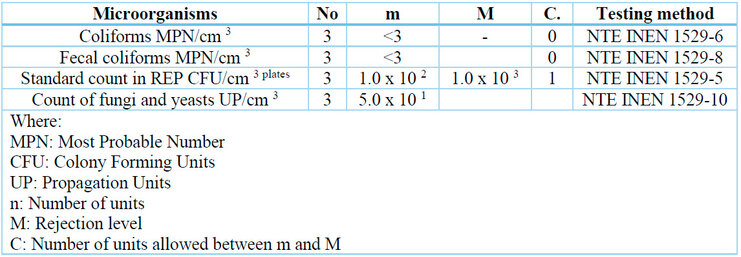
Table 1. Microbiological requirements for soft drinks.
Evaluation of the Sensory Table of Soft Drinks
The descriptive sensory analysis consisted of analyzing and evaluating the organoleptic characteristics of the product and the most relevant aspects of it, such as color, flavor and texture.
The organoleptic analysis will consist of 3 differentiated phases:
Appearance and visual presentation of the product, which encompasses two parameters
Clarity: The degree of transparency and brightness the liquid offers to the eye is measured; color: both the hue and intensity of the color of the sample presented are valued, which varies depending on the type of soft drink valued and its typicality.
Olfactory phase, in which three aspects are taken into account
Intensity: Power or olfactory magnitude of the valued sample. Openness: Aromatic limpidity of the analyzed reference. Absence of defective memories and the presence of natural memories outside of all artificiality. Quality: The soft drink has complexity and elegance in this olfactory phase. Positive sensations are all those that offer nuances of the aromatic range of the "raw material" from which its preparation starts (in this case, lemon emulsion), as well as the specification that the product can offer in its denomination.
The gustatory phase, in which five parameters are assessed. Intensity: Degree of strength of the soft drink in its taste phase; Openness: The non-appearance of unpleasant and typical flavors of the soft drink in question, free of defects, according to its composition, will be valued positively, Quality: A set of taste sensations that refer to the soft drink's character, complexity and personality, which can come from its raw materials and the additives used in its preparation. It represents the parameter with the highest valuation of those included. Balance: The balance of the different taste sensations as it pass through the mouth is studied, with particular attention to the fundamental flavors of sweetness and acidity. The "freshness" of the product will be considered positive, given the type of soft drink.
Persistence: Sensations similar to those perceived when the soft drink is in the mouth. Taste the length of the sample.19
Evaluation to Predict the Shelf Life of Soft Drinks.
Shelf life or stability studies of soft drinks were carried out in the quality control laboratory to determine when a food product will maintain its "fit for consumption" characteristic and its acceptance by the consumer.
Essentially, the shelf life of a food is defined as the time in which it will retain its physicochemical, organoleptic and nutritional properties.
Shelf life encompasses several facets of nutritional value, including safety, feeding value, and sensory characteristics. When this nutritional value is affected, it significantly influences consumer purchasing decisions.20
The fundamental factors that influence the shelf life of a product are Formulation, Prosecution, Packing, and Storage conditions.
To predict the product's shelf life under study, a refreshing drink based on the lemon emulsion, an oven programmed at 40°C and with a humidity of 70%, the parameters with which the products are transported, were used. They are stored in trolleys for distribution under such conditions.
The forms of deterioration affecting the product, subject to physiological and biochemical processes determining its quality, were identified during the study. These systems are complex due to their chemical, physical and biological composition; consequently, knowledge and control of these processes are essential to preserve quality characteristics, that is, acceptability and safety.20
The order of reactions, temperature, activation energy, and organoleptic and microbiological analyses must be considered to analyze the speed of deterioration reactions. Each sample was evaluated over time (independent variable at 10 levels).
The samples will be evaluated with the parameters detailed below:
Microbiologic analysis: Total count of mesophilic aerobic, Fungus and Yeast Count, Presence of total and fecal coliforms, Sensory evaluation: Acceptance Tests, Comparison tests (Triangular, Duo-Trio).
Once the evaluation time (4 months) has concluded, the data measured over time will be collected, and the product's shelf life will be established, which must comply with the optimal organoleptic characteristics and safety required according to the INEN 2304 standard. 20 Figure 1 shows the stove used.
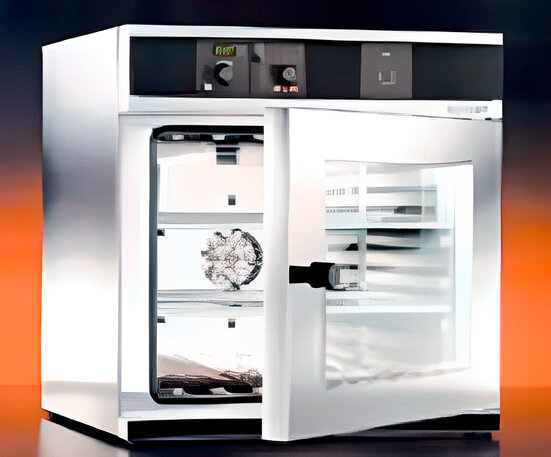
Figure 1. Measuring oven to predict shelf life in beverages. Source: 21
RESULTS
Results and Statistical Analysis of Microbiological Tests
The tests were carried out in triplicate for each microbiological parameter indicated in the Ecuadorian standard. In the case of total and fecal coliforms, the mere presence in the drink led to the rejection of the sample. According to the INEN 2304 standard, the results of coliforms are expressed <3 UFC/ cm3, which indicates the absence of the bacteria above in the sample evaluated. The counts of total aerobics, fungi and yeasts were taken to analyze the behavior concerning time.
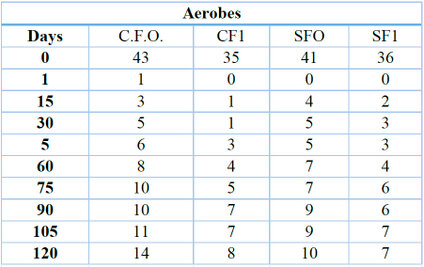
Table 2. Microbiological count in soft drink (UFC/cm3)
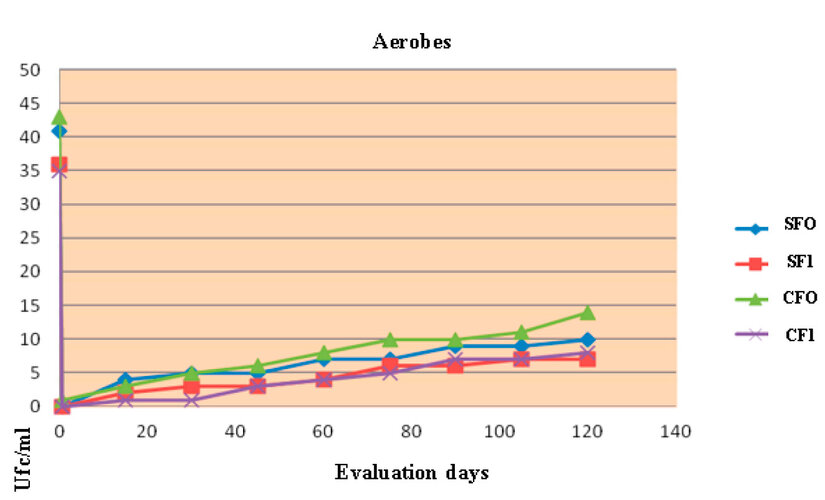
Figure 2. Behavior of aerobic soft drink evaluated for 4 months.

Table 3. Analysis of variance for the aerobic count.
Table 3 shows the ANOVA table and that the coefficient F equals 0.303654. Since the p-value of the F test is greater than 0.05, there is no statistically significant difference between the means of the four variables at 95.0%. These means are represented in Figure 3.
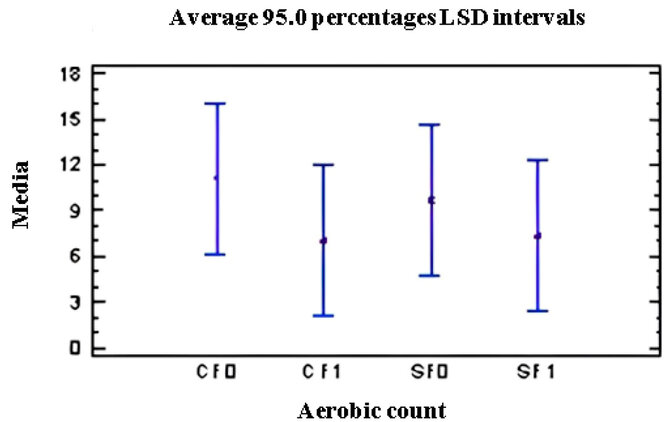
Figure 3. Graph of means (aerobic count)
Suppose only the values of the counts are considered after carrying out the pasteurization in Figure 3. In that case, a ratio F = 2.49 results are obtained for a p-value = 0.0784, which, being more significant than 0.05, would indicate no significant differences for 95% confidence. When the means are analyzed (Figure 4), it can be seen that the CF0 sample presents a slightly higher mean than the rest, so a multiple-range test was applied.
This test shows a statistically significant difference between CF0 and CF1 and CF0 and SF1. When sucrose has been partially substituted by sweetener, the average aerobic count is lower than when working with fiber and only with sucrose. This is because there is less substrate in the beverages, which contributes to reducing the growth of microorganisms over time. However, the product is within the standard, indicating a maximum of 100 UFC/cm3.
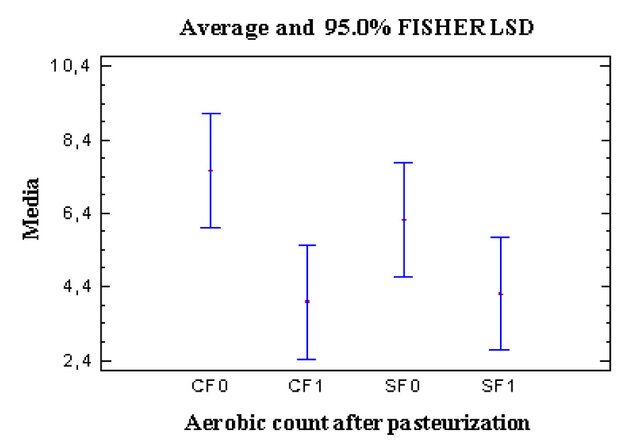
Figure 4. Aerobic count after pasteurization
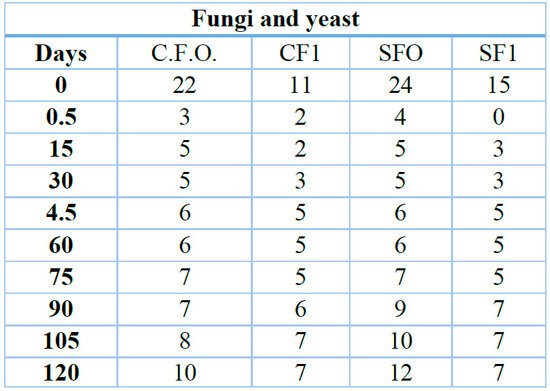
Table 4. Microbiological count of fungi and yeasts in the soft drink cfu/ cm3

Figure 5. Behavior of fungi and yeasts in soft drinks.

Table 5. Analysis of variance for fungi and yeast count
The ANOVA in Table 5 presents an F ratio of 1.33674, with a p-value greater than 0.05, where there is no statistically significant difference between the means of the 4 variables at 95.0% confidence.
Figure 6 presents the means for the samples and their confidence intervals.
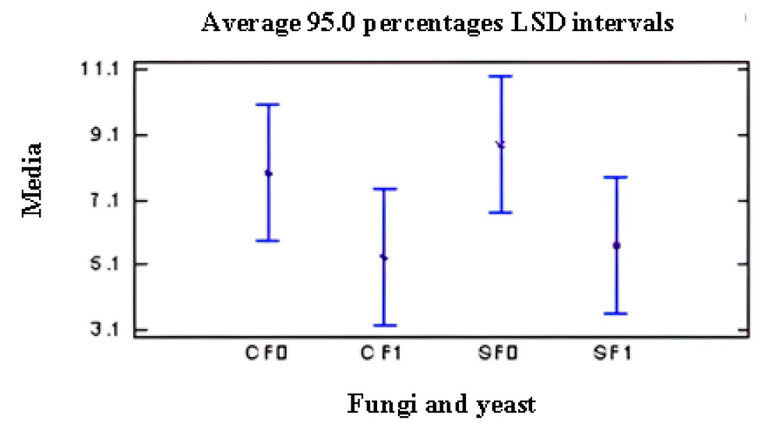
Figure 6. Graph of means (fungi and yeast)
The analysis of variance in Figure 6for the counts from 0.5 days after the pasteurization shows a ratio F=2.53 with p-value = 0.0744, where there are no statistically significant differences for the four samples. with 95% confidence. However, from the graph of the means (Figure 7), a slightly higher mean can be seen for the sample without fiber with 100% sucrose; this is the initial sample. This was verified with a multiple-range test finding two homogeneous groups.
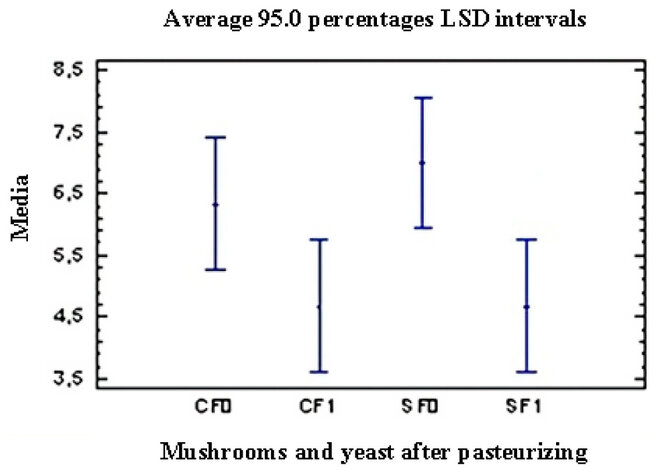
Figure 7. Graph of means (mushrooms and yeasts after pasteurizing)
Results and Analysis of Sensory Evaluation of Soft Drinks
It was explained to the sensory panel that the objective is to choose the formula with the taste threshold of best acceptance towards them. The method used is the hedonic scale test, based on a scale of liking and disliking the samples.
The scale comprises seven alternatives (table 6) divided into three for the level of liking, three for the level of dislike and one that specifies indifference to the sample.
The coding used was indicated in the Chapter on Materials and Methods. Four different formulas would be obtained according to the established formulation as specified.
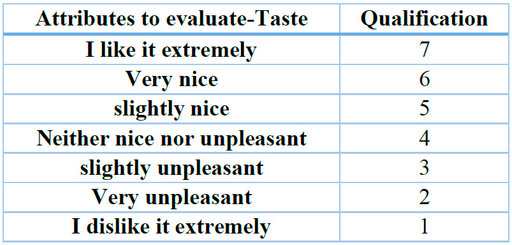
Table 6. Hedonic taste acceptance scale.
The evaluation results were tabulated based on the rating each judge attributed according to the coded samples. It should be noted that each sample was identified based on the processing time. To obtain the results, the average of each of them was determined. The evaluations were issued by the judges (Table 7).
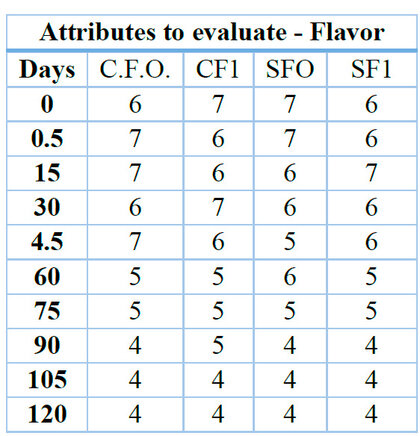
Table 7. Tabulation of results

Table 8. Analysis of variance for flavor
The ANOVA in Table 8 shows an F coefficient equal to 0.0695, with a p-value greater than 0.05, where there is no statistically significant difference between the means of the 4 variables at 95.0% confidence. Figure 8 shows this behavior.
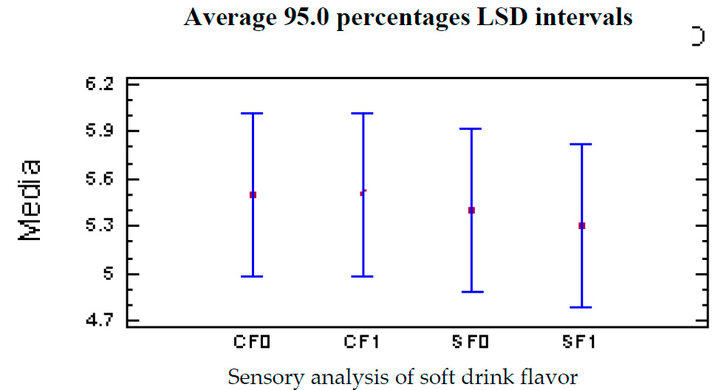
Figure 8. Graph of means (sensory analysis of the soft drink flavor).
However, there is a tendency to decrease the attribute's value as time increases, reaching values from three months after the drink is produced, framed in the criterion "neither pleasant nor unpleasant".
Formulation
The integrated analysis of the variables studied in the previous sections shows no significant differences between the samples. Therefore, for the formulation of the soft drink, it was decided to choose the sample coded as CF1, the soft drink sweetened with 60% sugar and 40% sucralose, where an evaluated fiber concentration of 1.60% by weight was obtained. According to the panel's result, sixty days is the time that was chosen as the product's useful life. The product enriched with dietary fiber and partially substituted with 40% sucralose presents the following formulation (Table 9).

Table 9. Sweetened soft drink formula
Characterization of the Final Product
Sweetened lemon-flavored refreshing drink
Storage and Handling
Store in a cool, dry place, free of odors and protected from the sun. Preferably drink cold.
Useful lifetime
2 months at 32ºC
Organoleptic parameters
Characteristic odor
Color Slightly yellow
Characteristic citrus flavor
Microbiological parameters
Mesophilic aerobes < 100 CFU /cm3
Yeasts and fungi < 50 UFC/cm3
Total Coliforms < 3 MPN/cm3
Fecal Coliforms < 3 MPN/cm3
DISCUSSION
The study by Machín mentions that yeasts tolerate pH between 3 and 4, but pH between 4.5 and 6.5 is more favorable for their growth. Therefore, the sweetened beverage is a medium for its growth as it is in the abovementioned pH ranges. 22
According to the results of other studies, it is agreed that pasteurization has positive effects on sweetened beverages, reducing the microbial load and guaranteeing food safety due to heat treatment.23
Coliforms are a family of bacteria commonly found on plants, soil, and animals, including humans. Coliform bacteria are generally found in greater abundance in the surface layer of water or bottom sediments. Fecal contamination has been, and continues to be, the leading health risk in water since it involves the incorporation of pathogenic microorganisms from patients and carriers and water transmission to the susceptible population. For this reason, sanitary control of microbiological risks is so important and constitutes an essential sanitary measure to maintain an adequate level of health in the population. 10
As for the study's results, it was found that the evaluated sweetened beverage met the INEN 2304 standard in terms of microbiological aspects, indicating a low microbial load and good microbiological stability. Furthermore, it was determined that the beverage had a shelf life of 6 months at room temperature, which is valuable information for the beverage industry.
Regarding the implications of these findings, it is essential to note that the results can be helpful in the formulation and production of sweetened beverages and in implementing quality control and food safety measures. For example, these results can be employed to establish an appropriate shelf life for the product and ensure its microbiological and sensory quality. Additionally, the findings can benefit food product regulation, as they provide valuable insights into product quality and consumer safety.
However, it is essential to consider the study's limitations and potential sources of error. For instance, the study focused on a single sweetened beverage, so the results may not be generalizable to other similar products. Furthermore, the specific microbiological analysis techniques used are not specified in the text, which could impact the accuracy of the results. Finally, the study did not include an analysis of the physical stability of the product, which could be a significant limitation in terms of product quality.
In summary, the study's findings hold significant implications for the beverage industry and food product regulation. Nevertheless, it's crucial to consider the study's limitations and potential sources of error when interpreting the results. In the future, conducting additional studies to assess the quality and safety of other food products and enhancing the accuracy of the microbiological and sensory analyses used in this study would be significant.
CONCLUSIONS
The sensory analysis reveals that the sweetened beverage does not significantly alter the beverage's flavor profile. However, the impact of adding these sweeteners over time becomes evident through the increase in the beverage's solid content. This increase can be attributed to water evaporation during the stability test, driven by differences in partial pressures, resulting in a higher concentration of soluble solids in the beverage.
Regarding microbiological behavior, it can be concluded that sweetened beverages comply with the INEN 2304 standard. This compliance is linked to the reduced substrate content in the beverages, contributing to a decline in microbial growth over time. As a result, extending the product's shelf life from two to three months is possible, based on the findings of the sweetened beverage study.
The study's key findings indicate that the evaluated sweetened beverage possesses suitable organoleptic and microbiological characteristics while enjoying favorable consumer acceptability. Furthermore, it has been determined that the beverage has a shelf life of 6 months at room temperature, as inferred from the study's results. These findings hold significant implications for the beverage industry, as they enable the establishment of an appropriate product shelf life and assurance of its microbiological and sensory quality. Moreover, the results obtained can guide decisions related to the formulation and production of sweetened beverages and the implementation of quality control and food safety measures. In summary, the study furnishes valuable insights into the beverage industry, contributing to enhancing product quality and safety for consumers.
REFERENCES
1. Acevedo L, Mendoza C, Oyón Rafael. Total and fecal coliforms, some enterobacteria staphylococcus sp. and moulds in salads for hot dogs sold in Maracay, Venezuela. Latin America Nutrition Archives [Internet]. 2001 [cited 2024 Feb 23];51(4):366–70. Available from: https://pubmed.ncbi.nlm.nih.gov/12012562/
2. Ancasi EG, Carrillo L, Benítez Ahrendts M. Moulds and yeasts in bottled water and soft drinks. Argentine Journal of Microbiology [Internet]. 2006 [cited 2024 Feb 23];38(2). Available from: https://www.researchgate.net/publication/6758660_Moulds_and_yeasts_in_bottled_water_and_soft_drinks
3. Anzaldua-Morales Antonio. La evaluación sensorial de los alimentos en la teoría y la práctica. 1994 [cited 2024 Feb 23]; Available from: https://www.editorialacribia.com/libro/la-evaluacion-sensorial-de-los-alimentos-en-la-teoria-y-la-practica_53649/
4. Fernández-Santisteban MT. Determination of total and fecal coliforms in water for technological use for centrifuges. ICIDCA About Sugar Cane Products [Internet]. 2017 [cited 2024 Feb 23];51(2):70–3. Available from: http://www.redalyc.org/articulo.oa?id=223154251011
5. García-Flores C, López-Espinoza A, Gabriela Martínez Moreno A, Patricia Beltrán Miranda C, Patricia Zepeda-Salvador A. Estrategias para la disminución del consumo de bebidas endulzadas. Revista Española de Nutrición Humana y Dietética [Internet]. 2018 Jul 12 [cited 2024 Feb 23];22(2):169–79. Available from: https://www.renhyd.org/renhyd/article/view/426
6. Gómez R. Sensient Food Colors. 2017 [cited 2024 Feb 23]. Totally natural opacifying emulsions for beverages. Available from: https://sensientfoodcolors.com/es-la/id/emulsiones-opacificantes-totalmente-naturales-para-bebidas/
7. Corrales LC, Antolinez Romero DM, Bohórquez Macías JA, Corredor Vargas AM. Anaerobic bacteria: processes they perform and their contribution to life sustainability on the planet. Nova [Internet]. 2015 [cited 2024 Feb 23];13(24). Available from: http://www.scielo.org.co/scielo.php?script=sci_arttext&pid=S1794-24702015000200007
8. Álvarez Munárriz L, Álvarez de Luis A. Estilos de vida y alimentación. Gazeta de Antropología [Internet]. 2009 Dec 3 [cited 2024 Feb 23]; Available from: https://digibug.ugr.es/handle/10481/6858
9. Huezo M. AN. Evaluación física y sensorial de un prototipo de bebida de maracuyá con semillas de chía (Salvia hispanica L.) y análisis químico de la semilla de chía [Internet]. 2008 [cited 2024 Feb 23]. Available from: https://bdigital.zamorano.edu/handle/11036/164
10. Ávila Pineda GT, Fonseca Moreno MM. Microbiological quality of juices prepared in family welfare homes in the northern area of Cundinamarca. 2008.
11. Quitral R V, Pinheiro F AC, Carrera P C, Gallo U G, Moyano S P, Salinas V J, et al. Effect of non caloric sweeteners in sensory quality of orange juice. Revista chilena de nutrición [Internet]. 2015 Mar [cited 2024 Feb 23];42(1):77–82. Available from: http://www.scielo.cl/scielo.php?script=sci_arttext&pid=S0717-75182015000100010&lng=es&nrm=iso&tlng=es
12. Zavaleta Mercado R. Preparation of sucrose syrups by volumetric measurements. Acta Nova [Internet]. 2011 [cited 2024 Feb 23];5(1):110–37. Available from: http://www.scielo.org.bo/scielo.php?script=sci_arttext&pid=S1683-07892011000100006&lng=es&nrm=iso&tlng=es
13. Seijas Noya I, Jaurena G, Wawrzkiewicz M, Gaggiotti M, Romero LA, Méndez M. Quality evaluation of soybean by-products. J Agric Res [Internet]. 2020 [cited 2024 Feb 23];46(2):258–66. Available from: https://www.redalyc.org/journal/864/86464924014/html/
14. Ponce Chauca JL, Torres Beltrán LM. Estudio de factibilidad para la creación de una empresa dedicada a la producción y comercialización de jugos naturales en el Distrito Metropolitano de Quito. 2011 [cited 2024 Feb 23]; Available from: http://dspace.ups.edu.ec/handle/123456789/4474
15. Vito Villa JJ. Determinación de la vida útil mediante pruebas aceleradas (ASLT) de un producto extruido enriquecido con concentrado proteico de pota (Dosidicus gigas). Universidad Nacional Agraria La Molina [Internet]. 2019 [cited 2024 Feb 23]; Available from: http://repositorio.lamolina.edu.pe/handle/20.500.12996/4195
16. León P ÁM, Montoya C OI, Motato KE, Granda DM, Acaro C, Restrepo JM, et al. Colombian Wild Lactic Acid Bacteria (Lab) Show Good Properties in Sourdough Manufacture. Vitae, Journal of the Faculty of Pharmaceutical Chemistry. 2006;13(2):26–35.
17. Noguera F, Gigante S. Principios de la preparación de alimentos. 2018;
18. Instituto Ecuatoriano de Normalización I. NTE INEN 1529-7: Control microbiológico de los alimentos. Determinación de microorganismos coliformes por la técnica de recuento de colonias. 1990;2.
19. Instituto Ecuatoriano de Normalización I. NTE INEN 1529-10-1: Control microbiológico de los alimentos. Mohos y levaduras viables. Recuentos en placa por siembra en profundidad. [Internet]. 2013 [cited 2024 Feb 23]. Available from: https://es.scribd.com/document/488093112/1529-10-1R-MOHOS-Y-LEVADURAS-VIABLES-pdf
20. Instituto Ecuatoriano de Normalización I. NTE INEN 2304: Refrescos o bebidas no carbonatadas requisitos [Internet]. 2017 [cited 2024 Feb 23]. Available from: https://es.scribd.com/document/537817176/nte-inen-2304-1
21. López MF. Temperatures and pasteurization times of Guarapo on the microbiological, physicochemical and organoleptic characteristics for a refreshing drink. 2022;
22. Suárez-Machín C, Garrido-Carralero NA, Guevara-Rodríguez CA. Yeast Saccharomyces cerevisiae and alcohol production - Review. ICIDCA About Sugar Cane Products [Internet]. 2016 [cited 2024 Feb 23];50(1):20–8. Available from: http://www.redalyc.org/articulo.oa?id=223148420004
23. Bermeo Pin ML, Chiadó Loor GD. Temperatures and pasteurization times of guarapo on microbiological, physicochemical and organoleptic characteristics for a refreshing drink. 2022 [cited 2024 Feb 23]; Available from: http://repositorio.espam.edu.ec/handle/42000/1689
Received: October 9th 2023/ Accepted: January 15th 2024 / Published:15 February 2024
Citation: Salazar Llorente E, Cabanilla M, Arias-Toro D, Medina G. Estimation of the shelf life of sweetened soft drinks based on microbiological and sensory analysis.Revis Bionatura 2024; 1 (1) 40. http://dx.doi.org/10.21931/BJ/2024.01.01.40
Additional information Correspondence should be addressed to
Peer review information. Bionatura thanks anonymous reviewer(s) for their contribution to the peer review of this work using https://reviewerlocator.webofscience.com/
All articles published by Bionatura Journal are made freely and permanently accessible online immediately upon publication, without subscription charges or registration barriers.
Publisher's Note: Bionatura stays neutral concerning jurisdictional claims in published maps and institutional affiliations.
Copyright: © 2024 by the authors. They were submitted for possible open-access publication under the terms and conditions of the Creative Commons Attribution (CC BY) license (https://creativecommons.org/licenses/by/4.0/).
